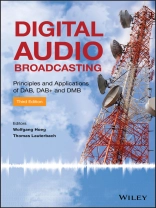Digital Audio Broadcasting revised with the latest
standards and updates of all new developments
The new digital broadcast system family is very different from
existing conventional broadcast systems. It is standardised in a
large number of documents (from ITU-R, ISO/IEC, ETSI, EBU, and
others) which are often difficult to read. This book offers a
comprehensive and fully updated overview of Digital Audio
Broadcasting (DAB, DAB+) and Digital Multimedia Broadcasting (DMB),
and related services and applications. Furthermore, the authors
continue to build upon the topics of the previous editions,
including audio coding, data services, receiver techniques,
frequencies, and many others. There are several new sections in the
book, which would be otherwise difficult to locate from various
sources.
Key Features:
* The contents have been significantly updated from the second
edition, including up-to-date coverage of the latest standards
* Contains a new chapter on Digital Multimedia Broadcasting
* ‘Must-have’ handbook for engineers, developers and
other professionals in the field
This book will be of interest to planning and system engineers,
developers for professional and domestic equipment manufacturers,
service providers, postgraduate students and lecturers in
communications technology. Broadcasting engineers in related fields
will also find this book insightful.
Table of Content
List of contributors.
Prefaces.
Foreword.
Abbreviations.
1 Introduction.
1.1 General.
1.2 Radio in the Digital Age.
1.3 Benefits of the Eureka 147 DAB Systems Family.
1.4 History of the Origins of DAB.
1.5 International Standardisation.
1.6 Relations to Other Digital Broadcasting Systems.
2 System Concept.
2.1 The Physical Channel.
2.2 The DAB Transmission System.
2.3 The DAB Multiplex.
2.4 Conditional Access.
2.5 Service Information.
3 Audio Services and Applications.
3.1 General.
3.2 Audio Coding and Decoding.
3.3 Characteristics of DAB Audio Coding.
3.4 DAB+ Coding Schemes.
3.5 Programme-associated Data.
3.6 Multichannel Audio with DAB.
3.7 Other Advanced Audio Application.
3.8 Quality of Service.
3.9 Audio Levels.
4 Data Services and Applications.
4.1 General.
4.2 Data Application Signalling and Access.
4.3 The Multimedia Object Transfer Protocol.
4.4 Standardised MOT User Applications.
4.5 Text Based Services.
4.6 Traffic Information Services and Navigation Aids.
4.7 Other Data Transmission Mechanisms.
5 Provision of Services.
5.1 The DAB Service Landscape.
5.2 Use of Existing Infrastructures.
5.3 Need for New Infrastructure.
5.4 Relationship between DAB Data Services and RDS.
5.5 Electronic Programme Guide (EPG) for DAB.
5.6 Possible New Audio Services.
6 Collection and Distribution Networks.
6.1 General.
6.2 The Collection Network.
6.3 The Distribution Network.
6.4 Example of Implementation.
7 The Broadcast Side.
7.1 General.
7.2 Introduction to DAB Networks.
7.3 Particularities of Single Frequency Networks (SFNs).
7.4 DAB Transmitters.
7.5 Radio Frequency Propagation Aspects.
7.6 Coverage Planning.
7.7 Coverage Evaluation and Monitoring of SFNs.
7.8 Frequency Management.
8 The Receiving Side.
8.1 General.
8.2 RF Front-end.
8.3 Digital Baseband Processing.
8.4 Audio Decoder.
8.5 Interfaces.
8.6 Integrated Circuits for DAB.
8.7 Receiver Overview.
8.8 Receiver Features.
9 Mobile Television and Multimedia.
9.1 Overview.
9.2 DAB – DMB.
9.3 DAB- IPDC.
9.4 Application Standardisation.
9.5 Conclusions.
Appendix 1 DAB Parameters for Modes I, II, III and IV.
Appendix 2 Frequencies for Terrestrial and Satellite DAB
Transmission.
Appendix 3 DAB System Protocol Stack.
Bibliography.
Index.
About the author
Editors
Wolfgang Hoeg, Audio Consultant, Berlin, Germany
Thomas Lauterbach, Georg-Simon-Ohm University of Applied Sciences, Nürnberg, Germany












